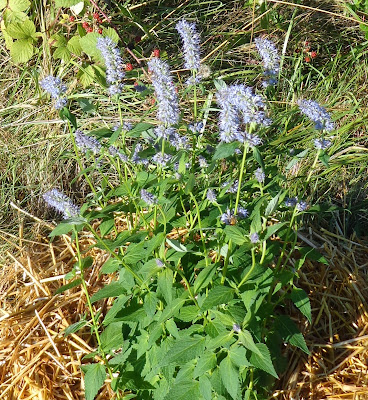 |
| Daisies, dandelions, hawthorns, blackberries |
I haven't seen many honeybees on the dandelions or daisies. They are eating something. I don't know what.
 |
| Caryopteris "Dark Night" and Canothus TLC plants from close-out sale. |
These plants are in place for a better tomorrow. They won't look like much for a year or two. They will need to be moved next year - will run out of room. This 'nursery' is good for now.
 |
| Catnip, lavender, lemon balm |
Also in 'nursery'. I grew the catnip from seeds. Next year it will have its own location. The lavenders were small seedlings, need more time to grow. The lemon balm is volunteer from yard in Vancouver.
 |
| Blackberries, Tilia americana, lemon balm |
Each of the trees gets a surround of an herb. Lemon balm, mint, oregano. Oregano is more compact compared to the other two - better choice for smaller trees. There is marjoram by the house - also compact, would be a good choice for smaller trees.
 |
| Buddleia hybrid "Miss Molly" |
So far not a lot of insects on the
Buddleia's. might be a mistake. They look nice. One of the few shrubs in bloom now. They are deer and rabbit resistant and should tolerate the dry summers with minimal effort. I did see butterflies on one. So they stay.
 |
| Cilantro in bloom |
This bed went to wildness. Cilantro is blooming - can provide seed if I time it right.
 |
| Lavatera "Barnsley Baby" - started as seedling. |
This lavatera was buried by snowpeas and turnip greens. Blooming now.
 |
| Apiary yard |
Nice setting for apiary.
 |
| Daisies and wild flowers |
 |
| Wildflowers |
 |
| Clover and dandelions |
 |
| Shrubs by the road |
The shrubs don't look like much now. Come Spring, they should take off and grow and bloom. TLC this year, pays off next year. Lots of grass clipping mulch.
 |
| Shallots in bloom |
Allowed the shallots to bloom. I don't care much about the bulb formation. When the flowers are done, I'll dig them up.
 |
| Perovskia / Salvia rusa "Little Spire" |
Te leaves of this
Perovskia have a nice medicinal fragrance - not exactly like sage or lavender, but there is a similarity. I'm doing to expect it to double in size next year. I was browsing Lowes garden department, and noted honeybees concentrating on the
Perovskia. So I bought one.
 |
| Caryopteris "Dark Night" and Penstemon "Red Riding Hood" |
They can be moved when bigger. The
Caryopteris came from Yard and Garden Land - same situation, they had more bees than any nearby plant. Back to Lowes, the
Penstemon was a major bee magnet, better than lavenders. They are over the hill, but the plan is to build up the apiary garden for next year and the year after.


























































